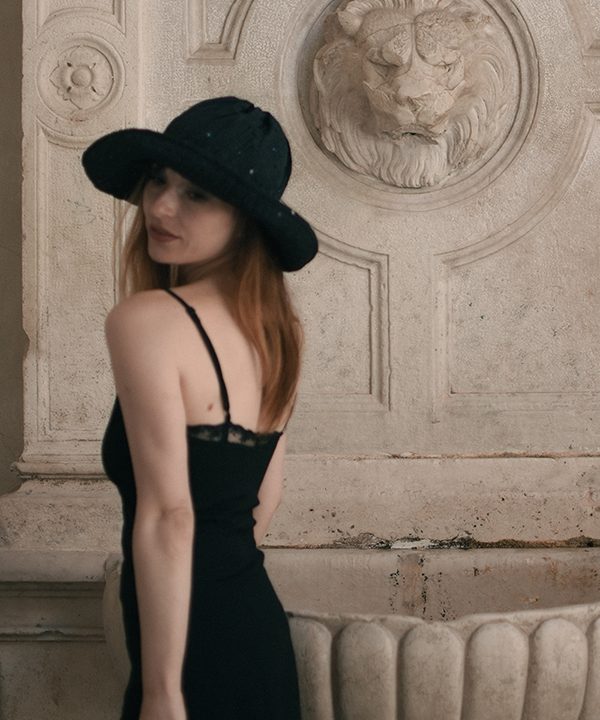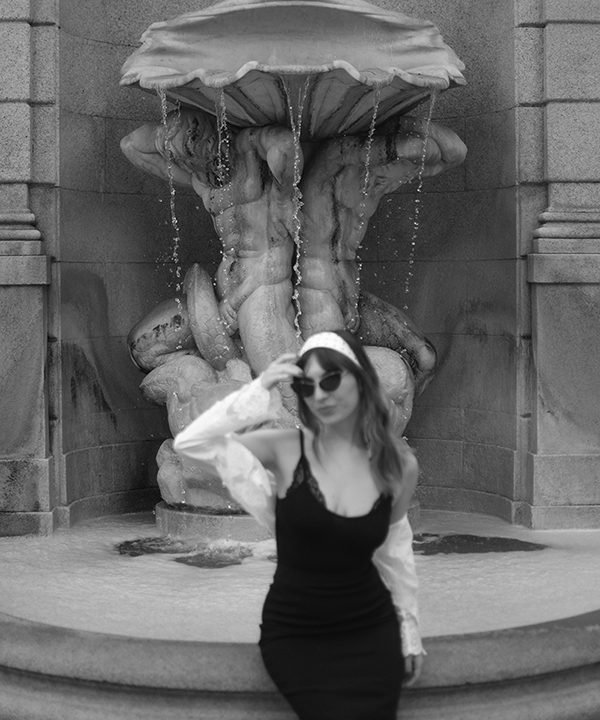
Golden Fragments
September 3, 2025
A Joke of Destiny
September 25, 2025

What about when one awoke from dreams, for example? Of course, there one could remember… But there were also surly dreams which one forgot completely, of which nothing remained but some mysterious aura; some obscure bemusement. — Schnitzler, Arthur, Dream Story
Among all points of inspiration, recently there has been a lot going on about escapism—taking breaks from reality by slipping into imagined narratives. Revisiting parts of our memories and merging them with made-up events; partly to explore what could have been, partly to let fantasy play around various scenarios. As the product, Alice-in-Wonderland-style images are made out of existing segments, pointing out that time, once envisioned, turns into the melting shapes of Dali’s paintings, telling us that it only passes according to our own comprehension.
When a mind wanders around stories for quite a while, daydream turns into dream, only to turn into conscious thoughts again—leaving us unaware of the border between the two stages. What we imagine, what we project onto subconscious visuals, and what we experience while awake sometimes seem as real and as blurry as the memory of a film we saw years and years ago. As in Schnitzler’s tale, where Albertine’s dream and Fridolin’s nocturnal wanderings appear as parallel fragments of the same blurred reality, the uncanny lies not in what takes place but in the impossibility of knowing whether it took place at all. No witnesses for either of them, no consequence for further life. Yet both seemed to be so real, almost touchable in the vivid reminiscences. Desire wearing the shape of nightmare. What unsettles is not simply what happens, but the impossibility of ever being sure whether it happened in the world or only in the unconscious theatre of the self. The uncanny of the story lies precisely there—in the refusal of experience to declare itself either dream or event, leaving behind the aura of what might have been.
During the night, either asleep or awake, the self is escaping its daylight version of the truth—and slipping into duality. Objects are rare, places strange, meetings sudden, yet all are haunted by repetition. As it is our own mind that we cannot escape from. Reality can be portrayed as unbiased, but is surely experienced subjectively. In the compulsion operative in objective chance, we tend to repeat a memory, whether actual or fantasmatic, in order to set our being free of it. I realised that I was allowing only those sudden events that let me feel melancholic desire, reminding me of lost places and moments, before I let them fade away. And by living the new ones that seemed a pure reminiscing of those past, I was creating a dreamy future, as I myself could not tell the difference between the stages. It was not that I was living in the past memory, but, on the contrary, I was putting them in a new context. By revisiting places once travelled, or encountering strangers who carried the echo of those who had already left, I experienced what the surrealists called trouvaille: the found object of reality itself, charged with the weight of memory. While in my dreams, instead of illogical events, I began to experience the filmic images of two rows of ambiguous figures: one of my former self, another of my former lovers.
And perhaps this is the true texture of memory: the shifting atmosphere of a room we once entered, unsure whether it belonged to reality, to a novel, or to the residue of a dream. The self is made of such echoes—where every scene carries both the certainty of having been lived and the suspicion of having only been imagined.
Che dire, ad esempio, quando ci si svegliava da un sogno? Certo, allora si poteva ricordare… Ma c’erano anche sogni cupi che si dimenticavano del tutto, di cui non restava altro che un’aura misteriosa; una vaga perplessità. — Arthur Schnitzler, Doppio sogno
Tra tutti i punti di ispirazione, di recente mi sono soffermata molto sull’evasione—il prendere pause dalla realtà scivolando in narrazioni immaginate. Rivisitare parti della memoria e fonderle con eventi inventati; in parte per esplorare ciò che avrebbe potuto essere, in parte per lasciare che la fantasia giochi con vari scenari. Come risultato, immagini in stile Alice nel Paese delle Meraviglie vengono costruite da frammenti esistenti, mostrando che il tempo, una volta immaginato, si trasforma nelle forme liquide dei quadri di Dalí, ricordandoci che scorre solo secondo la nostra percezione.
Quando la mente rimane a lungo immersa nelle storie, il sogno a occhi aperti diventa sogno vero e proprio, per poi tornare pensiero cosciente—lasciandoci ignari del confine tra i due stati. Ciò che immaginiamo, ciò che proiettiamo in immagini subconscie e ciò che viviamo da svegli a volte sembrano altrettanto reali e sfocati quanto il ricordo di un film visto molti anni fa. Come nel racconto di Schnitzler, dove il sogno di Albertine e le peregrinazioni notturne di Fridolin appaiono come frammenti paralleli della stessa realtà offuscata, l’inquietante non risiede in ciò che accade, ma nell’impossibilità di sapere se sia mai accaduto davvero. Nessun testimone per nessuno dei due, nessuna conseguenza per la vita successiva. Eppure entrambi sembravano così reali, quasi tangibili nei vividi ricordi. Il desiderio che prende la forma dell’incubo. Ciò che inquieta non è semplicemente ciò che accade, ma l’impossibilità di essere certi se sia avvenuto nel mondo o soltanto nel teatro inconscio del sé. L’inquietante del racconto sta proprio lì—nel rifiuto dell’esperienza di dichiararsi sogno o evento, lasciando dietro di sé l’aura di ciò che avrebbe potuto essere.
Durante la notte, sia dormendo che da svegli, l’io sfugge alla sua versione diurna della verità—scivolando nella dualità. Gli oggetti sono rari, i luoghi strani, gli incontri improvvisi, eppure tutti sono ossessionati dalla ripetizione. Poiché è la nostra stessa mente ciò da cui non possiamo fuggire. La realtà può essere descritta come imparziale, ma viene certamente vissuta in modo soggettivo. Nella compulsione che agisce nel caso oggettivo, tendiamo a ripetere un ricordo, che sia reale o fantastico, per liberarci da esso. Mi accorsi che lasciavo spazio soltanto a quegli eventi improvvisi che mi permettevano di provare quel desiderio malinconico che mi ricordava luoghi e momenti perduti, prima di lasciarli svanire. E, vivendo i nuovi episodi che sembravano puri richiami di quelli passati, stavo creando un futuro onirico, poiché io stessa non riuscivo a distinguere le fasi. Non era che stessi vivendo nel ricordo del passato, ma, al contrario, lo stavo collocando in un nuovo contesto. Rivisitando luoghi già percorsi, o incontrando sconosciuti che portavano l’eco di chi aveva già lasciato la mia vita, sperimentavo ciò che i surrealisti chiamavano trouvaille: l’oggetto trovato della realtà stessa, carico del peso della memoria. Nei miei sogni, invece di eventi illogici, cominciai a vivere immagini filmiche di due file di figure ambigue: una del mio sé passato, l’altra dei miei amanti passati.
E forse questa è la vera trama della memoria: l’atmosfera mutevole di una stanza in cui siamo entrati una volta, senza sapere se appartenesse alla realtà, a un romanzo o al residuo di un sogno. Il sé è fatto di tali echi—dove ogni scena porta con sé sia la certezza di essere stata vissuta, sia il sospetto di essere stata soltanto immaginata.












